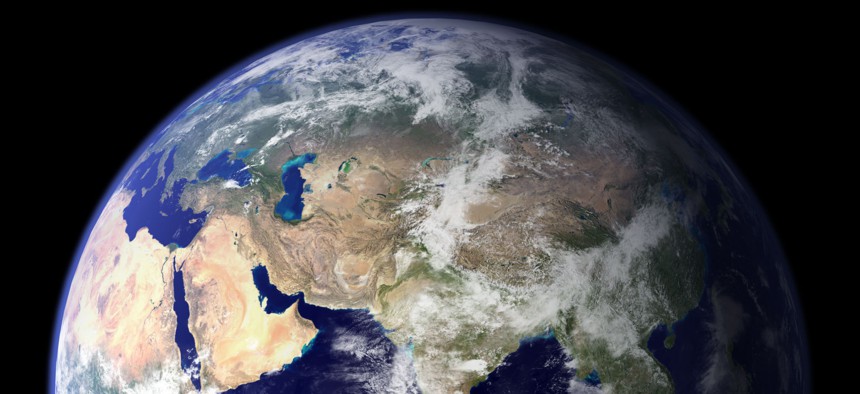Trump’s Paris Decision Hurts More than the Climate
America’s withdrawal will leave the world hotter, more erratic, politically fractured, and facing toward Beijing.
The politics of climate change requires constantly comparing the very small and the very massive.
On the one hand, the carbon-dioxide molecule: three atoms, bound together by electromagnetism, that in sufficient quantities can reflect heat energy back to its source. On the other, the whole planet, our island in the sky, Earth: a medium-sized rock orbiting a medium-sized star, veiled in a thin layer of gas that determines when it rains, when it snows, whether it is a good home.
Between these two extremes hangs the entire phenomenon of climate change: a planetwide convulsion in the normal functioning of Earth’s ocean currents and weather patterns. An excess of carbon dioxide in that narrow atmosphere has trapped a century of extra heat—pushing global temperatures higher and higher, reducing the polar ice caps to their lowest levels ever recorded, bleaching the Great Barrier Reef and cooking cities and towns in sweltering summer heatwaves.
Too many of those little molecules, it has become clear, risks subjecting Earth to the fastest climate change in 50 million years.
Related: US Intel Chief: Climate Change Is Adding Fuel to the World’s Extremist Fires
Also read: Climate Change Is Increasing the Risk of War in Africa: Study
On Thursday in the Rose Garden, President Donald Trump made little note of that problem as he announced that he will withdraw the United States from the Paris Agreement, the first international treaty to combat climate change.
“I am fighting every day for the great people of this country. Therefore, in order to fulfill my solemn duty to protect America and its citizens, the United States will withdraw from the Paris climate accord,” said Trump. He also said he would “begin negotiations to re-enter either the Paris accord or a really entirely new transaction on terms that are fair to the united states, its businesses, its workers, its people, its taxpayers.”
“And if we can’t, that’s fine,” he added.
Despite his decision to withdraw, the president will cohere to the legal terms of Paris. This means that the United States will not be able to give notice of its departure from the agreement until November 4, 2019, three years after the accord entered into force. And the country will not technically leave Paris until November 4, 2020—one day after that year’s presidential election.
What will this actually do to the Earth’s climate? For those of us who have to live with the consequences of global warming—who plan on seeing 2060, or at least expect our children to see it—will this make their lives worse? Or will it have no effect at all?
To fully answer that question, it requires stepping back and looking at other big things: how the Paris agreement works, and how the rest of the international community plans to avoid the worst of global warming.
As I wrote earlier this week, the Paris Agreement works by a delicate consensus mechanism: Instead of mandating restrictions from the top down, it asks every country to submit a nonbinding, voluntary plan to reduce its own emissions. Starting in 2020, and every five years after that, countries will issue new plans describing how they will further decrease emissions.
The nonbinding nature of the treaty allowed powerful but rapidly developing countries like India and China to sign on. Their participation sets the agreement apart from the Kyoto Protocol, an earlier attempt at an international climate-change treaty. Kyoto, whose negotiations were led in part by then-Vice President Al Gore in 1997, faltered after George W. Bush abandoned it during his first months in office.
The Paris Agreement’s voluntary nature also permitted the Obama administration to join the agreement through executive fiat. A Republican-controlled U.S. Senate would never have ratified a climate treaty, much less a binding one. From the U.S. legal perspective, Paris is essentially a UN resolution. Almost every clause describing U.S. involvement says that this country “should,” not that it “will”—a meaningful legal difference.
Now, however, there is a different president, and the international politics of climate change have shifted. More than 140 countries have now ratified the Paris accord, meaning that it will stay in legal force even if the United States leaves. And China, sensing an opportunity, has taken up the mantle of diplomatic leadership on this issue. It has joined with the European Union and promised to uphold the promises they made under the agreement. (Apart from the U.S., China and the EU are the two other major historical emitters of heat-trapping gases.)
Before this week, only two countries worldwide have exempted themselves from the agreement: Syria, which has been engaged in a hideous civil war since 2011; and Nicaragua, which argues the treaty is too weak and ineffective to combat climate change. Uzbekistan, previously the third holdout, joined the treaty in April.
Experts worry, though, that more countries could join them. Many developing countries—including Malaysia, the Philippines, and India, the fastest-growing country in the world—may abandon their promises if the United States strips the treaty of its diplomatic oomph. If they join Trump in reneging—India especially—then the world could keep increasing the amount of carbon dioxide in the atmosphere for decades to come, and it would miss the last opportunity to hold an increase in global temperature below 3.6 degrees Fahrenheit.
That number—equal to 2 degrees Celsius—is considered the threshold at which changes to the global climate system would become dangerous and irreversible.
In important ways, however, the Trump administration had backed away from its Paris commitments long before Thursday.
When it signed on to Paris in 2015, the United States promised to cut its greenhouse-gas emissions 25 percent below where they stood in 2005. To meet these goals, the Obama administration advanced a slew of new executive policies, including the Clean Power Plan for the electricity sector, fuel-economy standards for cars, and a rule limiting how much methane could be freely vented from public lands.
In less than six months in office, the Trump administration has systematically rolled back these rules, ceded to court challenges against them, or signaled that it will not strictly enforce them. He has also asked Congress to cancel the subsidies for renewable energy, and his Department of Energy is pursuing policies that Chuck Grassley, a Republican senator from Iowa, has decried as “anti-wind.”
With those policy changes already taking effect, it seems unlikely that—even if the United States remained in Paris—it could still meet its commitments under the treaty.
And that raises a broader question about the health—and ultimate fate—of the U.S. renewable-energy industry. Without support from the government, or access to the developing market through UN climate talks, American firms may be at a disadvantage negotiating with developing countries. It will make it far easier for China and Germany’s manufacturing sectors to dominate the renewable-energy industry, a trillion-dollar industry expected to more than quadruple in size.
Germany and China both aggressively subsidize their own clean-energy firms. And the EU and China have already planned to work closer with each other on climate-related research and technological development.
This possibility dominated a rare statement from Barack Obama, released as Trump was speaking. “The nations that remain in the Paris Agreement will be the nations that reap the benefits in jobs and industries. I believe the United States of America should be at the front of the pack,” he said. “For the nations that committed themselves to that future, the Paris Agreement opened the floodgates for businesses, scientists, and engineers to unleash high-tech, low-carbon investment and innovation on an unprecedented scale.”
If solar and wind companies in the United States falter—and if this country hunkers down into a fossil-fuel-dominated economy in the 2020s—then it may permanently deprive the American economy of a massive global opportunity. It could also undercut the U.S. claim to a century of global leadership on scientific research and technological development.
And perhaps most importantly, it will allow Germany and China to lead the world diplomatically on other issues, as well. At best, a Democratic president negotiating an international agreement which a Republican president then abandons will be interpreted as instability; at worst, it will throw other U.S. diplomatic commitments into doubt.
“Global statecraft relies on trust, reputation and credibility, which can be all too easily squandered,” has warned George P. Shultz, the U.S. secretary of state under President Ronald Reagan. “If America fails to honor a global agreement that it helped forge, the repercussions will undercut our diplomatic priorities across the globe.”
Which is to say: Trump’s decision to withdraw from Paris matters insofar as it causes other systems—Indian participation in the treaty, the American solar and wind business, and U.S. diplomatic leadership in the world—to collapse. And it lets us glimpse what this spinning world will look like in the decades ahead: hotter, more erratic, politically fractured, and facing toward Beijing.
NEXT STORY: Fortress Britain's Coming Crackdown






